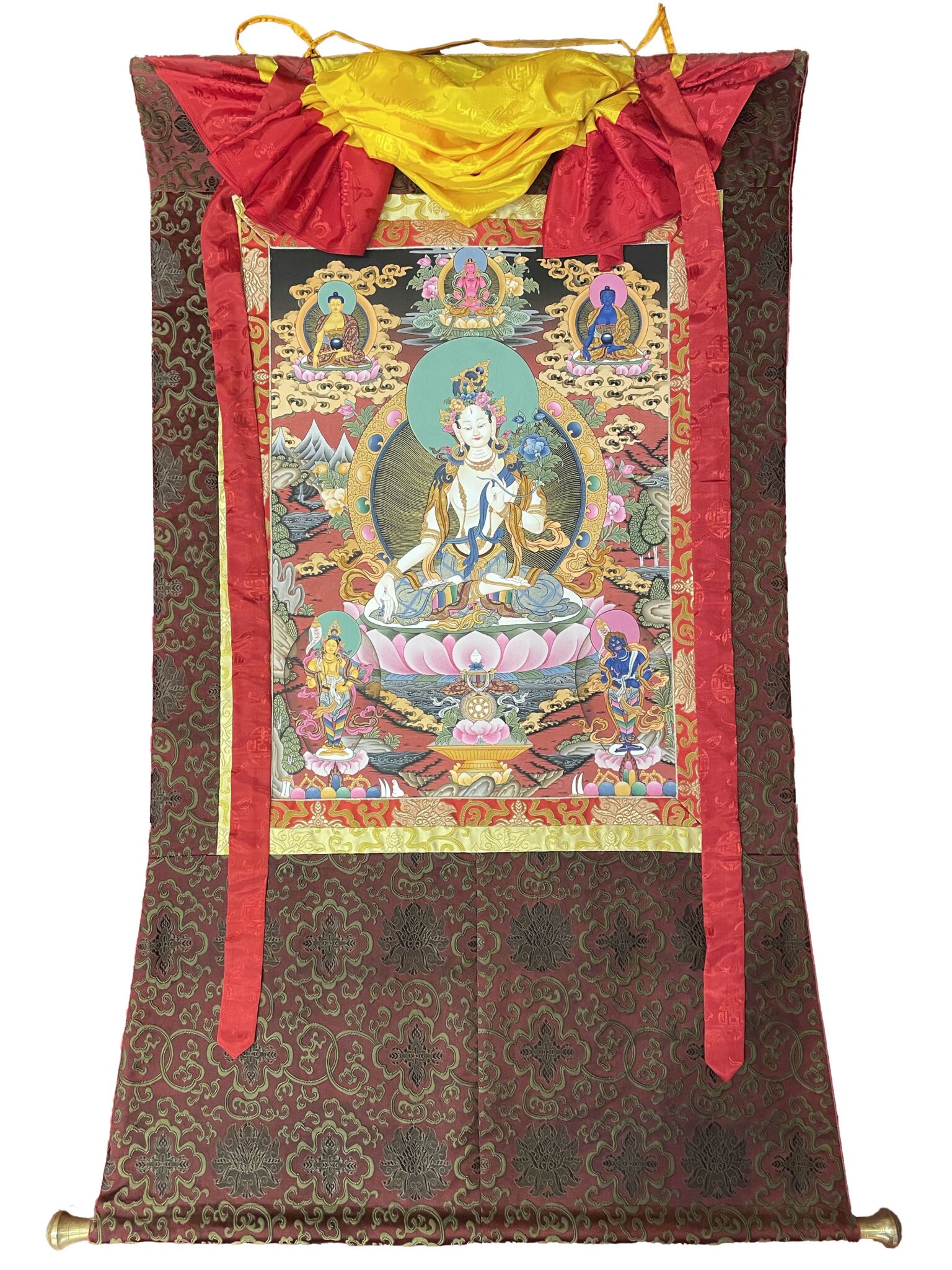







Dolma Karpo with Pancha Buddha Thangka
Dolma Karpo with Pancha Buddha Thangka is a hand-painted on cotton canvas in Kathmandu, Nepal. The size of this thangka is 60*46 cm (40*30 inch) .
Dolma Karpo is the main focus of the thangka, with Aparmita and Namgyalma situated in the lower right and left corners respectively. Pancha Buddha is presented at the top of Dolma Karpo in the thangka.
| Weight | 350 Grams – 0.77 lbs |
| Size | 50*75 cm (20*30 inch) |
| Material | Cotton Canvas & Natural Color |
Iconography of White Tara
White Tara is viewed as embodying the knowledge and freedom bestowed by all Buddhas. She is thought of as a representation of a maternal compassion that is even more powerful than a mother’s love for her own offspring, and she is determined to aid living creatures in escaping pain.
White Tara, the Mother of All Buddhas, is renowned for her swiftness in answering the pleas of those who call upon her. Her meditation practice is said to bring about health, long life, courage, patience, and tranquility. People often perform White Tara sadhanas to extend their lifespan and treat sickness. It is believed that since Arya Tara is the collective embodiment of the enlightened activity of all Buddhas, her sadhana is easily accomplished.
Gestures and Attributes
Her right hand is open towards us in the gesture of supreme generosity, signifying her ability to fulfill our spiritual and material needs.
She is making a gesture of giving blessings, protection, and security with her left hand. She has seven eyes, one on each hand and foot and the third eye on her forehead, symbolizing her knowledge and response to the suffering in the world; she is seated in the vajra posture, also known as the full lotus.
Her left hand holds the stem of a blossoming white lotus signifying her spiritual perfection and complete purity of body, speech, and mind.
The mantra of White Tara
OM TARE TUTTARE TURE MAMA AYUR PUNYE JNANA PUSHTIM KURU YE SVAHA
Iconography of Namgyalma
Namgyalma, also referred to as Ushnisha Vijaya, is located in the lower right corner of the White Tara Thangka. This deity is connected to longevity and purification, and her mantra has many positive outcomes.
It is said to be so powerful that anybody who hears it will never again be born from the womb. Therefore, if animals hear it, they will never again be reborn in the lower realms.
The mantra of Ushnisha Vijaya (Namgyalma)
Om Dhrum Soha Om Amrita Ayur Dade Soha
Iconography of Aparmita
Aparmita bottom left corner of white tara in the thangka. Buddha Aparimita is very popular in bestowing long life upon the devotees. He is red in color. His two hands are in dhyana mudra and hold an ambrosia vase.
He is usually decorated with the symbols of a Sambhogakaya Buddha, but never with a partner. He has a crown and a Ushnisha on his head.
The Buddha Aparimita is invoked to increase longevity, heal serious diseases quickly, and guard against imminent danger.
In the Nepalese Mahayana tradition, the dharani of Buddha Aparimita is often recited by devotees in the presence of those who are close to death. It is believed that reciting this dharani with true sincerity will be beneficial for the dying person.
It is said that the famous Madhyamika Buddhist philosopher Arya Nagarjuna was able to avert his untimely death by reciting this dharani for a full day and night.
The mantra of Buddha Aparmita
Om A Ma Ra Ni Dzi Wan Ti Ye Soha


















